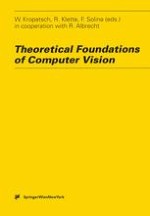1996 | OriginalPaper | Buchkapitel
Computer Vision and Mathematical Morphology
verfasst von : J. B. T. M. Roerdink
Erschienen in: Theoretical Foundations of Computer Vision
Verlag: Springer Vienna
Enthalten in: Professional Book Archive
Aktivieren Sie unsere intelligente Suche, um passende Fachinhalte oder Patente zu finden.
Wählen Sie Textabschnitte aus um mit Künstlicher Intelligenz passenden Patente zu finden. powered by
Markieren Sie Textabschnitte, um KI-gestützt weitere passende Inhalte zu finden. powered by
Computer Vision and Mathematical Morphology. Mathematical morphology as originally developed by Matheron and Serra is a theory of set mappings, modeling binary image transformations, which are invariant under the group of Euclidean translations. This framework turns out to be too restricted for many applications, in particular for computer vision where group theoretical considerations such as behavior under perspective transformations and invariant object recognition play an essential role. So far, symmetry properties have been incorporated by assuming that the allowed image transformations are invariant under a certain commutative group. This can be generalized by dropping the assumption that the invariance group is commutative. To this end we consider an arbitrary homogeneous space (the plane with the Euclidean translation group is one example, the sphere with the rotation group another), i.e. a set X on which a transitive but not necessarily commutative transformation group Г is defined. As our object space we then take the Boolean algebra P(X) of all subsets of this homogeneous space. Generalizations of dilations, erosions, openings and closings are defined and several representation theorems can be proved. We outline some of the limitations of mathematical morphology in its present form for computer vision and discuss the relevance of the generalizations discussed here.
